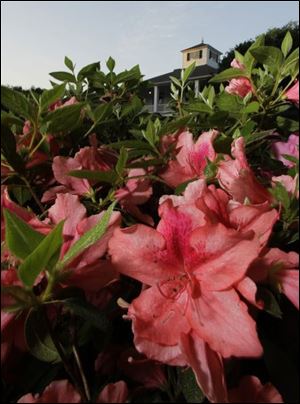
Beauty defines the Masters; gorgeous scenery mixes with history
4/10/2008
Azaleas bloom in front of the clubhouse at Augusta National. Those lucky enough to get on the grounds for the Masters take as many pictures of the scenery as they do the star golfers.
AUGUSTA, Ga. - Ann Curtis came in the back gates of Augusta National expecting little more than a nice day with her husband. She is not a golfer, has never been here, but what she saw gave her a start.
"I'm not one that's easily awed," she said. "It's just breathtaking."
Before her was a cathedral of spring - home to the Masters golf tournament, yes, but also something more. An annual rite, an emergence from the gray of winter into a blaze of color from the green grass to the pink and fuchsia azaleas to the white dogwoods.
It's a mystique that doesn't wear off, even for the likes of Arnold Palmer and Butch Harmon after more than half a century. Harmon was a toddler when his father, Claude, won the Masters 60 years ago. Palmer, perhaps the most beloved figure at Augusta, won the first of his four green jackets exactly 50 years ago.
"There are so many stories here," Harmon said on the green-carpet porch of the white clubhouse.
"That's what is so great about this place," Palmer quietly replied.
Today's stars understand that too.
"This major is so important to all of us," Tiger Woods said. "It's such a special event."
Woods appreciates the beauty of Augusta National, but he's here for the golf. The world's No. 1 player sent expectations higher than a Georgia pine when he said earlier this year that the Grand Slam - winning all four majors in the same year - was "easily within reason." He has won eight out of his last 10 tournaments and is an even-money favorite to win his fifth Masters, odds never before seen in golf.
He played 18 holes on Sunday and Monday, nine holes on Tuesday and spent the final day of practice on the driving range and the putting green, skipping the Par 3 Tournament because he wanted no distractions.
For so many others, Augusta National is all about distractions.
The Masters is the only major held on the same golf course every year, and it has been televised every year since 1956. Fans and players alike grow up watching the tournament on the second weekend of April. They know the holes. They remember the shots. They can recite the history. But they can't recreate the beauty.
Tom Kolvek of Vero Beach, Fla., brought his wife here for her 60th birthday. He purchased a book on the history of the club and took notes before passing through the gates yesterday, studying the contours of the land and the flowers named for every hole - Tea Olive, Golden Bell, Redbud, Holly - all of them found on this former nursery.
"It's like going to church," Kolvek said.
He took a picture on every hole, even if there were no world-class golfers in the background. It is not unusual to see fans stooped over an azalea bush, the camera inches away from the blooms.
Christine Hancock moved to Maryland from Augusta, but she returns each year for the Masters. For her, it is the definition of spring. For others, it signals the start of the golf season.
"A month before it happens, you get this draw to be here and nothing stands in your way," she said. "Everything that symbolizes and speaks to spring is here. It's just gorgeous."
But for all the flowers, there are just as many footprints left by history.
Each hole contains a Masters moment, from Ben Crenshaw making a 60-foot birdie putt on the 10th hole in 1984, to Sandy Lyle hitting out of the cavernous bunker on the 18th to 10 feet for a birdie to win by a single stroke 20 years ago.
The Masters is the youngest of the four majors, created in 1934 by the great Bobby Jones. Even so, perhaps no other golf tournament celebrates its history quite like Augusta National, and yesterday was a perfect example.
Playing the 18th hole by himself was Larry Mize, who turns 50 later this year. He's remembered as the local kid who chipped in for birdie on the 11th hole in 1987 to beat Greg Norman in a playoff, still one of the most celebrated shots at the Masters.
Mize has never even practiced that shot over the last 21 years.
"It's a pure memory," he said. "I don't want to ruin it."